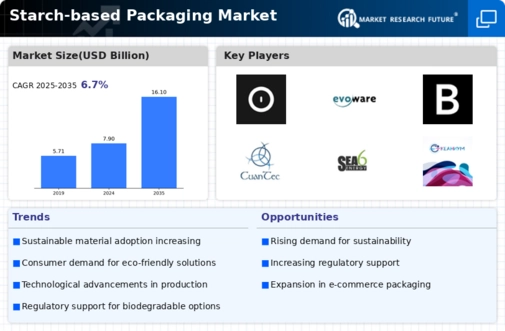Starch Based Packaging Size
Starch based Packaging Market Growth Projections and Opportunities
Starch-based Packaging Industry is, certainly, being shaped and influenced by a large number of factors that are cumulatively at play. Tissue-based packaging, that is naturally-renewable material such as corn, potatoes and cassava, has become a common alternative film and plastic packaging. One of the major footprints for Starch-based Packaging is the escalating world environment awareness of the issues and the bringing forward of the sustainable packaging solutions. There is a market gap that is the raised demand for packaging materials that degrade and decompose easily, brought about by consumers choices, companies sustainability initiatives and by regulations from the government.
According to 2022 Starch-based Packaging Market Size report this market was over USD 6.9 Billion. The Statistics depicts that Starch Packaging has the highest potential in terms of revenue by as much as 15.32 Billion at 2032 from where we are now (in terms of value) which is 6.70% compound annual growth rate.
Biotechnology-worked polymers processing is one of the main drivers of the Starch-based Packaging market. Still, research and development go on in starch-based film area, which is concentrating on the fine-tuning of the barrier and mechanical properties of the material, boosting its performance and expanding the range of its applications. For the food sector, the objective of management of the quality of packaging is to meet the changing demands of the industries that are already widely using starch-based packaging, such as moisture resistance and shelf life.
While the impact of Starch-based Packaging the Government regulations and policies on is significant, they have a major influence on the market of Starch-based Packaging. The problem of plastic pollution and single-use packaging as a green problem are a motivating factor in creating rules in place to favour green alternatives. The role of the market is effectively influenced by differential pricing, bans, and standard to speed use of starch-based materials from packaging.
Increasing consumer awareness and preferences act as main factors driving Starch-Based Packaging market. With the growing concern among consumers on the need for sustainable options and increasing their demand for transparency, the acceptance of starch-based packing has gained ground. Educational billboards, labeling the products, and generation of certification platforms are aimed at the consumers to encourage their buy-in starch based-packaging and to create the market for eco-friendly options.
The economy conditions as they relate to consumers spending habits and corporation commitments for sustainability have an impact on the Starch-Based Packaging market. The promotion of economical growth and the expansion of social responsibility become the main factors when the green packaging options appear in the market. On the other hand, economic recessions are likely to affect the marketers as businesses review their spending policies, and people adjust their buying behaviors in the changed economy, this can cause some temporary disarray.











Leave a Comment